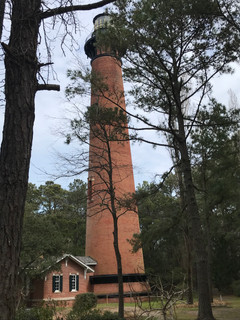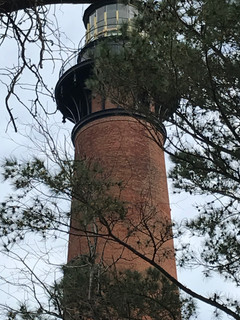Currituck Lighthouse
- gailgauvreau
- Jul 31, 2020
- 3 min read
The Five Lighthouses of the Outer Banks – Part Four
Currituck Beach Lighthouse
Staggered along the coast of the Outer Banks of North Carolina, are five historic and interesting lighthouses, each with a story to tell. The lighthouses are the actual buildings that contain the lights that warn vessels of danger, while the term light station refers to the buildings that form the entire complex (lighthouse, light keeper house etc.).
Recap from Part One
“Prior to our visit to the Outer Banks, I confess to being totally in the dark about the five lighthouses. We arrived in Nags Head for a three-month winter stay in January 2020, and the idea was to walk the beaches, enjoy the water views, and I was hoping the ocean would be an inspiration as I finished my next book, which focuses on cruising. We also thought we might see a few of the sights that we had heard about on a quick visit to Nags Head in 2018.
One day, while looking at items in one of the ubiquitous antiques stores in the Outer Banks, I found some old postcards of the area and I came across two depicting lighthouses. I asked the proprietor about the subject of the postcards and he provided me with a brief history about the five lighthouses located nearby. Once back at our rental home, a little internet research produced more information and we were soon set to start out on our lighthouse exploration.”
On a beautiful March day, before the Covid-19 pandemic resulted in Canadians being asked to return home, we drove north along Highway 12 to the Currituck Beach Lighthouse. From Nags Head to Corolla, it took us just under an hour (about 32 miles), as we passed through Kill Devil Hills and Kitty Hawk. The lighthouse is off the main highway and can be located on Corolla Village Road. The route was well-signed and there was no issue finding the lighthouse.
The lighthouse is in the heart of Corolla. Standing 162 feet in height, it is distinctly different than the other lighthouses we had seen, as it had not been painted and is reddish-brown brick in colour. We were told it can be seen about 18 nautical miles out to sea and like the other lighthouses of the Outer Banks, it was built to help guide vessels along the coast and keep them way from the shoals and shifting sand bars.
You will note from the picture I took of the sign, that the lighthouse was closed for the winter, so the best we could do was to stand outside a white picket fence and photograph the exterior of the lighthouse and building from the perimeter. We had hoped to be able to climb the 220 steps of the lighthouse so we could take advantage of the reportedly great view, but unfortunately those plans had to be put aside. We did read that there is a small fee to climb the steps and the sign indicated that children under 7 are admitted free of charge. Unlike the Brodie Lighthouse that had its Fresnel Lens replaced, the Currituck lighthouse retained its giant Fresnel lens and you can still see it in operation to this very day.
The construction of the lighthouse began in 1872 and the light lit for the first time in December of 1875.
As mentioned, the light station and lighthouse were closed when we arrived but since we were not going to be in the area when it was open, we saw what we could, walked the neighbourhood and picked up information about the lighthouse’s history from the available signage. The lighthouse museum shop is open at the same time as the lighthouse (early spring until late November). If you are there in the summer when everything is open, be prepared to sign a waiver before climbing the interior lighthouse steps. From the literature I read, the little museum has information about the history of the lighthouse and the various keepers. We decided that another trip to the area is in order as there are sufficient places of interest to draw us back “in season”. The area just north of this location is where the famous wild horses are generally found.
Before leaving the area, we decided to stop at the Historic Corolla Village before heading south and visiting the Outer Banks Center for Wildlife Education and peruse the Whalehead (a restored historic house), in the area called “Historic Corolla”. Our visit, and what we found there, will have to be the subject of another blog.
As usual, if you have any comments or questions about this blog entry, please feel free to contact me or post your comments.


























Comments